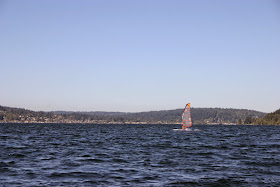We tried to go out for a Labor Day sail. We got out and hoisted the sail, but
there was no wind. It would sometimes kick up a little gust for a few seconds,
but then back to nothing. There was a fair amount of wave action on the water,
but it was not coming from the wind.
As we were attempting to hoist the mainsail, we managed to snag it and we had
to repair a rip. Fortunately, we keep sail tape in the toolbox.
We dropped sail and motored up to the North end of the lake to pick up Greg's
parents, hoping the wind would pick up. After bringing them aboard, we headed
back into the lake under motor. We raised the sails, but there just was not
any wind. There is a name for a sailboat with no wind: a raft.

|
|
The motor safety interlock.
|
|
We decided to drop sail again and motor back. We ran into another
problem...the motor would not start. The pull rope seemed to be jammed. No
wind and no motor!
We popped the cover off the motor and took a look, which is when Sandi
realized that there is a safety interlock that keeps from pulling the rope
while the throttle is not fully at idle. The throttle was cranked up just
enough to trigger the interlock. Just twisting the handle back to idle caused
the problem to go away.
We kind of have an eclectic set of knowledge. Sandi sailed quite a bit, even
sailing Catalina 22s a long time ago, but none of the boats she sailed had
motors. The rest of the crew has limited boating knowledge, so we are still
making a lot of small mistakes. We still do little things like sitting on the
port jib lead when trying to pull on the starboard lead; the jib does not move
much! Or forgetting to cleat the mainsail halyard after bringing the sails
down, which allowed the slack halyard to get snagged on the mast steaming
light. As we all get more experienced, we should reduce the number of these
problems.
We dropped the parents off again and motored all the way back to the dock. A
very frustrating day for sailing.









